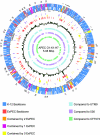The genome sequence of avian pathogenic Escherichia coli strain O1:K1:H7 shares strong similarities with human extraintestinal pathogenic E. coli genomes
- PMID: 17293413
- PMCID: PMC1855855
- DOI: 10.1128/JB.01726-06
The genome sequence of avian pathogenic Escherichia coli strain O1:K1:H7 shares strong similarities with human extraintestinal pathogenic E. coli genomes
Erratum in
- J Bacteriol. 2007 Jun;189(12):4554
Abstract
Escherichia coli strains that cause disease outside the intestine are known as extraintestinal pathogenic E. coli (ExPEC) and include human uropathogenic E. coli (UPEC) and avian pathogenic E. coli (APEC). Regardless of host of origin, ExPEC strains share many traits. It has been suggested that these commonalities may enable APEC to cause disease in humans. Here, we begin to test the hypothesis that certain APEC strains possess potential to cause human urinary tract infection through virulence genotyping of 1,000 APEC and UPEC strains, generation of the first complete genomic sequence of an APEC (APEC O1:K1:H7) strain, and comparison of this genome to all available human ExPEC genomic sequences. The genomes of APEC O1 and three human UPEC strains were found to be remarkably similar, with only 4.5% of APEC O1's genome not found in other sequenced ExPEC genomes. Also, use of multilocus sequence typing showed that some of the sequenced human ExPEC strains were more like APEC O1 than other human ExPEC strains. This work provides evidence that at least some human and avian ExPEC strains are highly similar to one another, and it supports the possibility that a food-borne link between some APEC and UPEC strains exists. Future studies are necessary to assess the ability of APEC to overcome the hurdles necessary for such a food-borne transmission, and epidemiological studies are required to confirm that such a phenomenon actually occurs.
Figures



Similar articles
-
Comparative genomic analysis shows that avian pathogenic Escherichia coli isolate IMT5155 (O2:K1:H5; ST complex 95, ST140) shares close relationship with ST95 APEC O1:K1 and human ExPEC O18:K1 strains.PLoS One. 2014 Nov 14;9(11):e112048. doi: 10.1371/journal.pone.0112048. eCollection 2014. PLoS One. 2014. PMID: 25397580 Free PMC article.
-
Diversity and Population Overlap between Avian and Human Escherichia coli Belonging to Sequence Type 95.mSphere. 2019 Jan 16;4(1):e00333-18. doi: 10.1128/mSphere.00333-18. mSphere. 2019. PMID: 30651401 Free PMC article.
-
Prevalence of avian-pathogenic Escherichia coli strain O1 genomic islands among extraintestinal and commensal E. coli isolates.J Bacteriol. 2012 Jun;194(11):2846-53. doi: 10.1128/JB.06375-11. Epub 2012 Mar 30. J Bacteriol. 2012. PMID: 22467781 Free PMC article.
-
Avian pathogenic Escherichia coli (APEC).Vet Res. 1999 Mar-Jun;30(2-3):299-316. Vet Res. 1999. PMID: 10367360 Review.
-
[Avian pathogenic Escherichia coli (APEC)].Berl Munch Tierarztl Wochenschr. 2003 Sep-Oct;116(9-10):381-95. Berl Munch Tierarztl Wochenschr. 2003. PMID: 14526468 Review. German.
Cited by
-
Development of colloidal gold immunochromatographic strips for detection of Riemerella anatipestifer.PLoS One. 2015 Mar 30;10(3):e0122952. doi: 10.1371/journal.pone.0122952. eCollection 2015. PLoS One. 2015. PMID: 25822983 Free PMC article.
-
Complete genome sequence of Crohn's disease-associated adherent-invasive E. coli strain LF82.PLoS One. 2010 Sep 17;5(9):e12714. doi: 10.1371/journal.pone.0012714. PLoS One. 2010. PMID: 20862302 Free PMC article.
-
Identification of protective and broadly conserved vaccine antigens from the genome of extraintestinal pathogenic Escherichia coli.Proc Natl Acad Sci U S A. 2010 May 18;107(20):9072-7. doi: 10.1073/pnas.0915077107. Epub 2010 May 3. Proc Natl Acad Sci U S A. 2010. PMID: 20439758 Free PMC article.
-
Derivation of Escherichia coli O157:H7 from its O55:H7 precursor.PLoS One. 2010 Jan 14;5(1):e8700. doi: 10.1371/journal.pone.0008700. PLoS One. 2010. PMID: 20090843 Free PMC article.
-
Dominance of Escherichia coli sequence types ST73, ST95, ST127 and ST131 in Australian urine isolates: a genomic analysis of antimicrobial resistance and virulence linked to F plasmids.Microb Genom. 2023 Jul;9(7):mgen001068. doi: 10.1099/mgen.0.001068. Microb Genom. 2023. PMID: 37471138 Free PMC article.
References
-
- Altschul, S. F., W. Gish, W. Miller, E. W. Myers, and D. J. Lipman. 1990. Basic local alignment search tool. J. Mol. Biol. 215:403-410. - PubMed
-
- Barnes, H. J., J. P. Vaillancourt, and W. B. Gross. 2003. Diseases of poultry, p. 631-652. Iowa State University Press, Ames, IA.
-
- Binnewies, T. T., Y. Motro, P. F. Hallin, O. Lund, D. Dunn, T. La, D. J. Hampson, M. Bellgard, T. M. Wassenaar, and D. W. Ussery. 2006. Ten years of bacterial genome sequencing: comparative-genomics-based discoveries. Funct. Integr. Genomics 6:165-185. - PubMed
-
- Blanco, M., J. E. Blanco, M. P. Alonso, and J. Blanco. 1994. Virulence factors and O groups of Escherichia coli strains isolated from cultures of blood specimens from urosepsis and non-urosepsis patients. Microbiologia 10:249-256. - PubMed
-
- Blanco, M., J. Blanco, J. E. Blanco, and J. Ramos. 1993. Enterotoxigenic, verotoxigenic, and necrotoxigenic Escherichia coli isolated from cattle in Spain. Am. J. Vet. Res. 54:1446-1451. - PubMed
Publication types
MeSH terms
LinkOut - more resources
Full Text Sources
Other Literature Sources
Molecular Biology Databases

